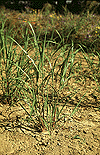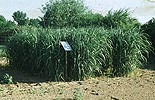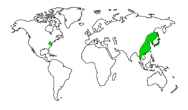Miscanthus sinensis
Grass family (Gramineae)

|
 |
| Miscanthus sinensis "Gigantheus" in year of planting |
after three years |
Source: Bock D., MPI
Distribution, Yield, Use:
- Distribution:
Distribution area extends to Japan, South Kurile islands, Eastern Soviet
Union, China, Manchuria, Taiwan and Eastern USA; counts as a hardy, undemanding
plant; growth in wind-shielded areas on well-drained humus ground is recommended.
- Yield:
| Year of planting |
no yield |
| 2nd year |
8-10 t/ha TM |
| 3rd |
20-30 t/ha TM |
| following years |
at 4-5 m height |
- Use:
Fibres (Cellulose) Energy use (burning)

Region of origin:  Region of cultivation:
Region of cultivation: 
- Cultivation and Breeding:
Miscanthus sinensis, a perennial grass variety, was originally used in
limited amounts as fodder in its place of origin in East Asia, as ground
cover to stop erosion, and as an ornamental grass. A special high-growing
variety, "Giganteus", was introduced into Denmark from Japan
in 1935, but was given scarce attention as an ornamental plant. This grass
variety became attractive in the course of the search for an economically
suitable supply of qualitatively high quality cellulose. A more economical,
large scale growth of Miscanthus sinensis should be guaranteed by the use
of biotechnological propagation methods (tissue culture, micropropagation).
- Breeding aims:
Breeding is concentrated on high dry mass and cellulose yield. Attention
is therefore directed towards stability, cold tolerance, stem formation,
useful life, water and soil requirements, assimilation and transpiration
characteristics and harvesting time.
Text by Dr.
Wolfgang Schuchert
Adapted to HTML by R.Saedler

![]() Region of cultivation:
Region of cultivation: ![]()